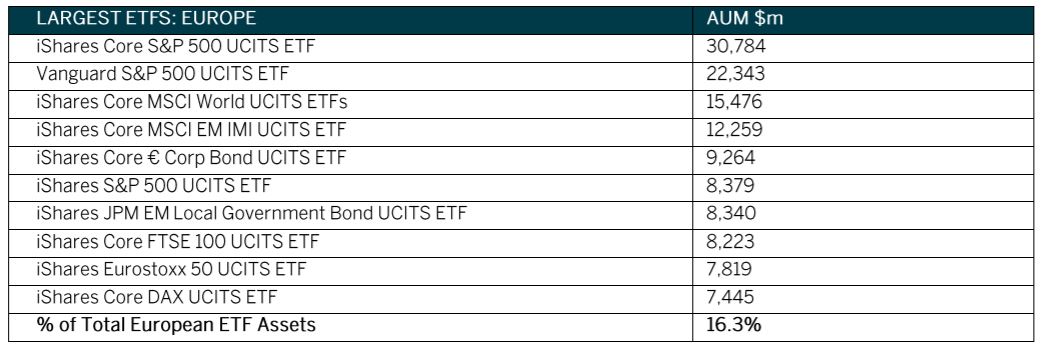Asset managers without an ETF range in Europe will be sweating under the collar at the fear of missing out on the huge flows seen in recent years but crucial barriers to entry remain.
European ETF assets have grown substantially since the Global Financial Crisis from under €150bn in 2008 to €760bn, as at the end of March, with Morningstar predicting this figure will hit €2trn by 2024.
The market is dominated by ETF providers owned by large financial institutions such as iShares, which BlackRock purchased off Barclays in 2009, Xtrackers, which is owned by DWS, and Societe Generale-owned Lyxor. These three players control 63% of total European ETF assets with iShares controlling almost half (44%).
Furthermore, the top 10 largest ETFs in Europe account for 16.3% of total assets ($131bn) and except for one Vanguard product, are all iShares vehicles.

Source: HANetf and ETFGI
Despite these giant players controlling the majority of assets, it is becoming evidently clear if asset managers want to be a major player, they will need an ETF business.
Large businesses have recognised the need for this with giants such as JP Morgan, BMO and Franklin Templeton all launching ranges in recent years.
As HANetf, in a white paper entitled Climb Higher: Concentration & Competition in Europe’s ETF Market, says: “Without an ETF range, asset managers risk being excluded from the many distribution channels that are focused on ETFs and will be at a significant competitive disadvantage to managers who recognised the distribution potential of ETFs earlier on.”
However, a number of barriers remain with asset managers having to invest heavily in areas such as product development, paid market making, index licenses, registration and passporting, and listing an exchange fees, if they want to be successful. All before the firm’s ETF has been launched, HANetf estimates these could cost in the region of €1-5m, all before the firm’s ETF has been launched.
Furthermore, the European market itself is a structural barrier to entry when compared to the US due to its fragmented nature. The US has the benefit of one currency, one regulatory environment and a consolidated tape.
However, issuers in Europe have to deal with over 20 exchanges and a vast array of different local platforms, all of which have different rules and adoption rates of ETFs.
Furthermore, distribution in Europe is far more nuanced with ETF appetite varying in the different countries. For example, in Italy, the retail adoption of ETFs has been far quicker than in France. Understanding this and “getting it right can be the difference between a successful fund and a failure,” HANetf says.
Andrew Craswell, senior vice president and responsible for ETF business development in Europe at Brown Brothers Harriman, adds: “Regulatory and trading fragmentation continue to be the main challenges to Pan-European ETF distribution. Distribution of ETFs is different in each European market, which makes it difficult for ETF issuers to have a homogenous approach to distribution across the region.”
HANetf says it is important new players try to differentiate from the rest of the marketplace. What European investors do not need is another Euro Stoxx 50 or S&P 500 however, it is well documented the lack of innovation being seen when compared to the US.
Solutions
While the possibility of launching an ETF range in Europe remains, the challenges highlighted show it is a daunting task and one that has high business risk.
One possibility is entry through acquisition and there are a number of asset managers with big ETF ranges rumoured to be up for sale.
Earlier this year, it was reported executives at WisdomTree had been looking to sell the business at the back end of 2018 while DWS’s Xtrackers range is being eyed up this side of the pond. Legal & General Investment Management took this approach by purchasing ETF Securities’ Canvas platform.
Another approach of launching an ETF business, which hit European shores in 2017 via HANetf, is through a white-label ETF platform. By providing regulatory and operation and capital markets infrastructure, platforms such as HANetf remove several of the barriers to entry.
Whichever way asset managers slice and dice their entry into the European ETF marketplace, one factor remains constant; they will want to get their foot in the door sooner rather than later.




